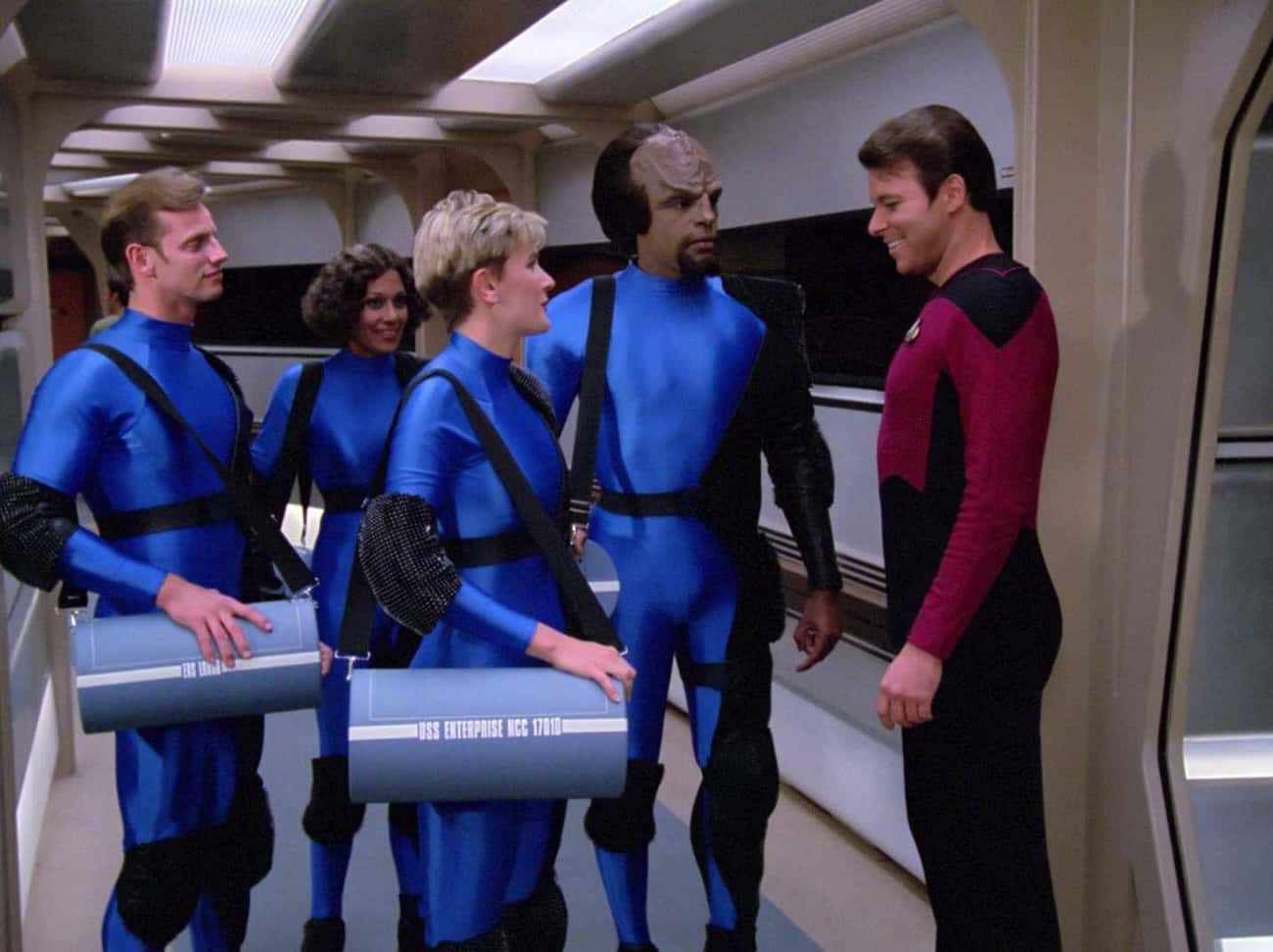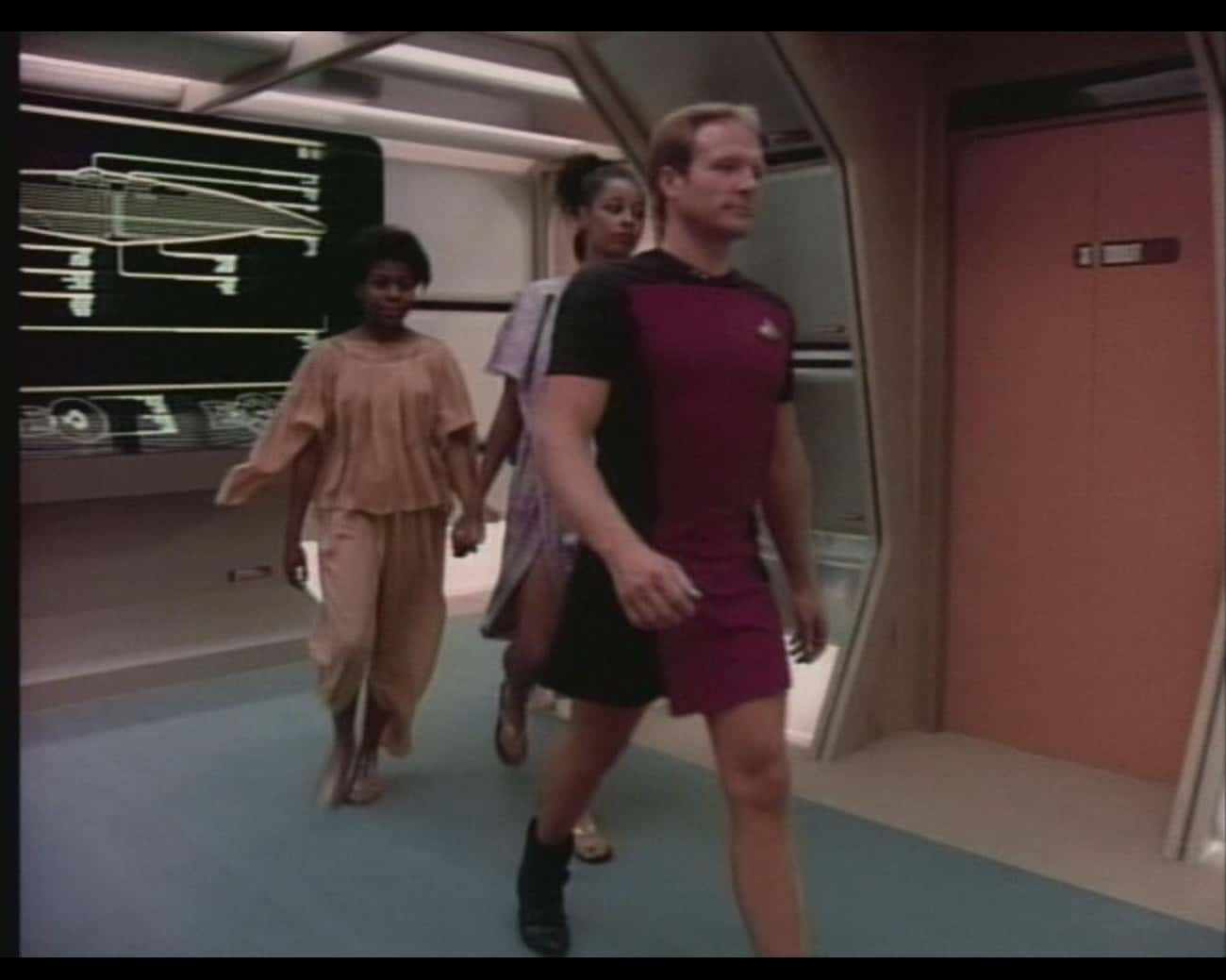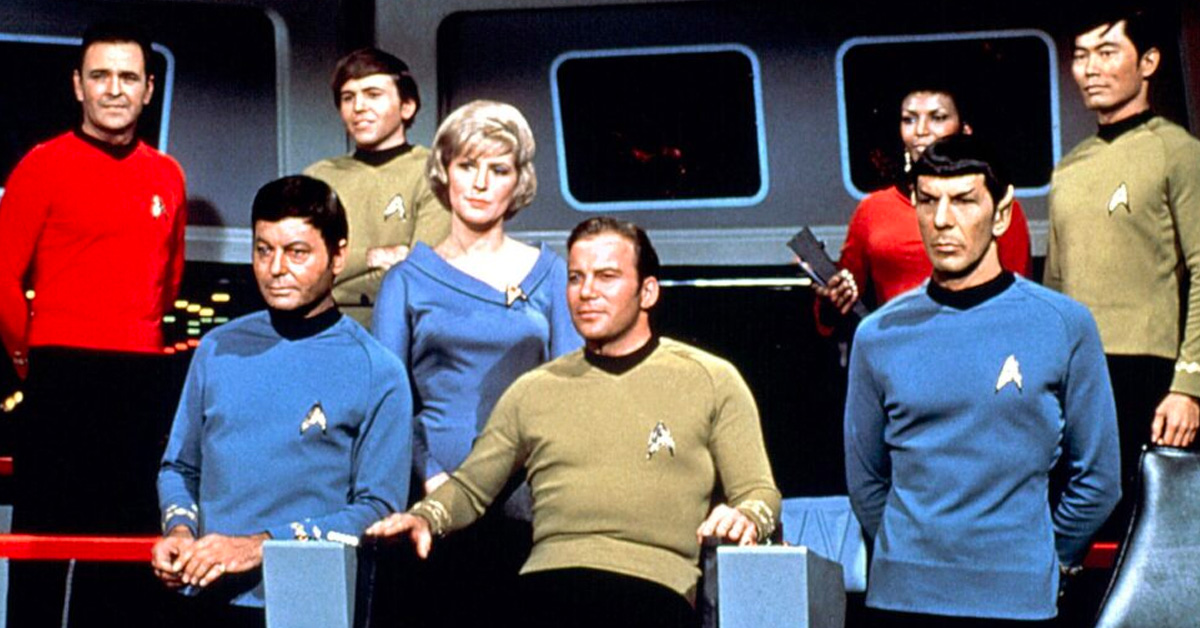The Star Trek franchise began in 1966 with Star Trek: The Original Series, and all these years later, Trekkies continue to obsess over the esteemed characters of the Starfleet. As unforgettable as the several series and films of the Star Trek franchise may be, it’s Star Trek‘s costuming that continues to astound Trekkies and non-Trekkies alike.
The trailblazing science-fiction franchise was infamous for their wardrobing style as they frequently battled against network censorship rules and ever-changing audience demographics. Constantly faced with problems like spandex over-stretching as well as deciding what 24th century fashion would even look like, Star Trek‘s wardrobe department should be long remembered for their many costuming achievements.
While Star Trek‘s costumes are easily some of the most memorable among all of the science-fiction genre, the wardrobe department has plenty of behind-the-scenes stories about the several obstacles that were faced to achieve this wide regarded success. From the many impracticalities of Jeri Ryan’s Borg costume to why Patrick Stewart was always seen doing the ‘Picard Maneuver’, here are 16 Star Trek secrets about the costumes for any curious Trekkies out there.
1. Just Narrowly Avoiding Physical Harm

Photo: Paramount Domestic Television
To an observer, spandex may seem like the world’s easiest garment to wear. Super stretchy, light, and form-fitting, it looks like it should be comfortable. But looks can be deceiving, according to designer Robert Blackman:
Jumbo, or Super Spandex, whatever you want to call that heavier weight stretch, will stretch from side to side or top to bottom, depending on how you cut the garment. So the costume would dig into the actors’ shoulders, wearing them 12 or 15 hours a day.
Blackman explained that pressure from the spandex led to back problems among the cast. Patrick Stewart, who starred as Captain Jean-Luc Picard, was told by his chiropractor that he should sue Paramount for the “lasting damage done to [his] spine.”
2. Feeling A Bit Faint

Photo: Paramount Domestic Television
In her first appearance on Voyager, Seven of Nine was outfitted in a full Borg drone costume. This proved incredibly dangerous for actor Jeri Ryan.
Unfortunately, the designers failed to consider the practicalities of actually wearing the complicated suit. The collar pressed repeatedly into Ryan’s carotid artery and the reduced blood flow to her brain caused her to become lightheaded.
Things only improved slightly for Ryan after she was de-Borged. Her famous silver catsuit was so tight, the actor once joked, “If I got goosebumps, you could see them.”
3. Get A Secret Off Their Chest

Photo: Paramount Domestic Television
Possibly one of the biggest wardrobe secrets in Star Trek is that most of its space women have artificially augmented chests. Not in the surgically enhanced way, but rather in the padded bra kind of way. The built-in support for female crew members runs through most of the TV franchise, from The Original Series to Enterprise.
Nicknamed the “Industrial Strength Starfleet Brassiere,” it was praised by cast members like Marina Sirtis, who played Deanna Troi. “I used to take it off at night and go, ‘Oh blimey, where did they go?'” she told fans in 2010. However, others allegedly rejected the extra padding. Kate Mulgrew, who played Captain Kathryn Janeway on Star Trek: Voyager, is rumored to have thrown hers on a producer’s desk and refused to wear it.
4. There Was Always A Lingering Smell

Photo: Paramount Domestic Television
Spandex, the preferred material for all Golden Age superhero costumes, was also the fabric of the future for the Star Trek universe. Creator Gene Roddenberry was completely sold on it. However, according to costume designer Robert Blackman, the material had some pretty icky side effects:
Spandex retains odor, so there is a certain part where if you’re wearing them for a long period of time, you can’t really clean all the smell out, and it becomes a little bit annoying. And it also retains the odor of the dry cleaning fluid. It is, on a day-to-day basis, unpleasant.
5. Never The Right Size

Photo: Paramount Domestic Television
To fulfill Gene Roddenberry’s wish to have the uniforms of The Next Generation be as figure-hugging as possible, designer Robert Blackman deliberately made each costume two sizes too small for the wearer. This had the added effect of putting the cast in a constant state of paranoia about any perceived bodily imperfections. “Spandex is unforgiving,” Blackman admitted. “So if you have any sorts of body issues, they are there.”
“We hated our space suits,” LeVar Burton told Entertainment Weekly. “As much as they call it a stretch fabric, spandex in that configuration doesn’t give all that much. It hid nothing.”
6. Neckline’s Were Very Important

Photo: Paramount Domestic Television
Next Generation fans will be familiar with Deanna Troi’s collection of multicolored unitards that she wears throughout the show’s early seasons. During an appearance at DragonCon in 2010, Marina Sirtis said she felt the lowered neckline of the garment affected her character’s intelligence:
There are certain rules in Hollywood. One of the rules is… if the chick has cleavage, she cannot have a brain. So, [after wearing a standard uniform in the pilot] I got cleavage, and all my gray matter departed. Which was sad, because originally – I know this is gonna shock you – Troi was supposed to be the brains of the Enterprise.
This all changed in the episode “Chain of Command,” in which the strict Captain Jellico takes control of the Enterprise and wages an offensive on Deanna’s cleavage. He unsubtly declares, “I’m used to a certain formality on the bridge.” To Sirtis’s delight, producer Ronald D. Moore had her switch to the standard Starfleet uniform in place of the offending unitard. It was a change that stuck. As Sirtis explained:
I was thrilled to finally be in a spacesuit. First of all, my pips [were visible] – ’cause I had a rank, you know. […] Suddenly, I was smart again. My cleavage had gone. My gray matter came flooding back.
7. Creating The Picard Maneuver
Video: YouTube
The spandex uniforms on The Next Generation were stinky, sweaty, painfully uncomfortable, and judging by Patrick Stewart’s infamous compulsion for tugging on his costume, they rode up into some awkward places. In order to prevent this, the Enterprise‘s Captain Jean-Luc Picard was continually caught on camera trying to pull the material down.
The gesture is affectionately known to fans as the “Picard Maneuver.” Though it’s really just a wardrobe malfunction, it became an accepted quirk of his character.
8. Skirts Were For Everyone

Photo: Paramount Domestic Television
Eagle-eyed fans of Star Trek: The Next Generation may have spotted male crew members strolling around the ship waering miniskirts early in the show’s run. Considering that female crew members, like Natasha Yar, were often seen sporting trousers, fan theories speculated that Starfleet uniforms were all unisex, with the choice of skirt or pants coming down to personal preference.
This theory was confirmed in The Art of Star Trek by Judith and Garfield Reeves-Stevens. The skirt/pants combo was dubbed a “skant” and considered “a logical development, given the total equality of the sexes presumed to exist in the 24th century,” the book states.
9. Refusing To Wear Uncomfortable Costumes

Photo: Paramount Pictures
The established color-coded shirts from The Original Series were replaced by a wardrobe of drab and unflattering Starfleet uniforms in Star Trek: The Motion Picture. Unfortunately, this naturalistic approach proved to be an unnatural eyesore, as crew members’ ranks were no longer as quick to read as they were originally designed to be.
Additionally, because the costumes’ trousers were attached to the shoes, the outfits were also ludicrously impractical. Actors required assistance whenever they needed a bathroom break, and the cast hated them. Their complaints ensured the unappealing costumes never again graced any Starfleet crewmembers… at least, not in the same boring colors.
10. A Sudden Change In Style

Photo: Paramount Domestic Television
Facing the threat of cancellation, Enterprise producers knew changes had to be made to pull in a bigger audience. It was during this time that – suspiciously – T’Pol (Jolene Blalock) saw a number of drastic changes to her wardrobe. Though co-creator Brannon Braga insists the main reason for sexing up T’Pol’s look was “a creative one” related to changes in the character’s life, costume designer Robert Blackman thinks differently.
“The ratings dropped, that’s the frank, real answer,” he shared in 2003. “If you want the show to run seven years, you have to think about demographics.” According to Blackman, the show needed to cater to a younger male demographic. Season 3 also happened to feature T’Pol’s first-ever scenes sans clothes, in the episodes “Impulse” and “Harbinger.”
11. Moving Around Wasn’t So Easy

Photo: Paramount Domestic Television
Following all the smelly and painful problems associated with spandex, designer Robert Blackman decided to try wool in the third season of The Next Generation. There was still one major drawback, though: wool is stubbornly inflexible.
“If you watch the first six or seven episodes [of Season 3], you’ll see the actors look like they’re in spandex outfits but they’re made of wool and the actors can’t move,” Blackman recalled. “They can’t raise their arms, they can’t do anything.” He soon got around the problem by redesigning the uniform as a two-piece.
12. Jeri Ryan’s Costume Was Beyond Impractical

In Voyager, the “ribs” protruding from Jeri Ryan’s costume were explained as mechanical implants, remnants from Seven of Nine’s time with the Borg collective. In reality, they were intended to strategically hide the corset hidden within the catsuit.
But those ribs came at a major cost to Ryan’s comfort. She couldn’t easily bend over or sit down and required assistance to take the whole thing off when she needed a toilet break. “If I had to go to the bathroom, it was a 20-minute production shutdown,” Ryan said in a 2012 interview. Later in the series, Ryan was outfitted in a brown version of the costume made from thicker fabric, which eliminated the need for the corset and all the awkwardness that came with it.
13. Engineering The Perfect Fit

Photo: Paramount Domestic Television
Seven of Nine’s impossibly tight catsuit in Voyager invites both fan adoration and objectification. The fabric was supposed to be as form-fitting as skin, but to avoid the fabric being stretched out from “high point to high point,” as actor Jeri Ryan put it, costume designer Robert Blackman sculpted chest “mounds” for her specially designed corset.
In an interview with Huffington Post, Ryan praised the design as a “real feat of engineering,” with the caveat that wearing the contraption was “an event.
14. All In The Small And Minute Details

Photo: Paramount Pictures
The Starfleet uniforms of young Kirk, Spock, Uhura, and the rest of the crew in J.J. Abrams’s cinematic prequel managed to maintain the most recognizable elements of the original costumes – the colors, style, and miniskirts – while adding in some modern updates.
One noticeable change is that all crew members wear sleek, black undershirts beneath their color-coded uniforms. A far less apparent difference is the Starfleet insignia actually covers the entire shirt in a repeated, embossed pattern. This close-up image offers a clear look at the detail.
15. Choosing The Perfect Color

Photo: Paramount Pictures
Star Trek II: The Wrath of Khan welcomed back the bright colors that had been purged from the first Star Trek movie. The brown and beige hues worn by Kirk and the crew in their initial voyage to the big screen were replaced with rich dark red military uniforms – a style inspired by Naval attire.
However, this color choice was more than just a creative one. Look closely and you’ll see the new costumes are secretly the old beige ones from The Motion Picture, just dyed red. That particular shade of burgundy was selected because it stuck to the fabric best.
16. Getting Creative With Censorship Rules

Photo: Paramount Domestic Television
The Original Series is infamous for its fabulous – and sometimes ridiculous – 1960s sci-fi space wear. Seductive alien women (whom Captain Kirk awkwardly hit on in the name of intergalactic peace-keeping) were dressed in some very fashion-forward ensembles that exposed parts of the female anatomy not normally associated with eroticism. Network censorship inspired some of the wardrobe department’s most creative decisions. Women’s bellybuttons were considered deeply offensive to public sensibilities in the ’60s, so NBC wouldn’t allow any outfits that revealed them. To avoid the network’s censorship rules, costume designer William Ware Theiss instead gave audiences a tantalizing glimpse of hips, upper arms, bare sides, and whatever else he could get away with.

